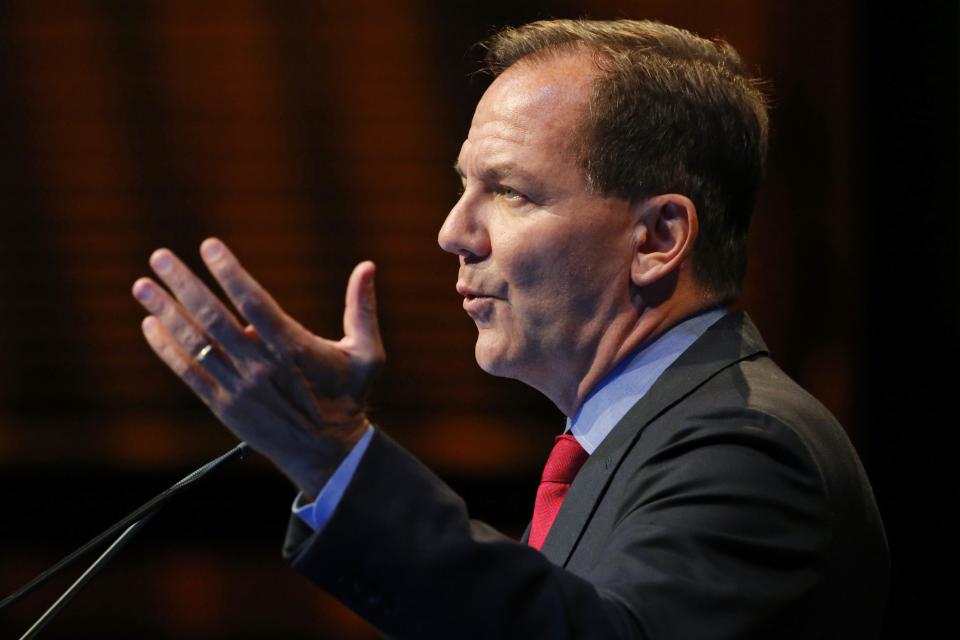Paul Tudor Jones: I'd rather be holding hot coal than U.S. Treasury bonds
Legendary macro trader Paul Tudor Jones predicted that tax reform would have huge implications on the markets.
Jones, who rarely makes public comments on the markets, sent an investor update on February 2 just ahead of this week’s wild swings in the market with the S&P 500 moving into correction territory.
In the letter, he highlighted how President Trump’s State of the Union address on Jan. 30 touting “the biggest tax reforms in American history” should frighten investors who’ve amassed more than $3 trillion in bonds into mutual funds and exchange-traded funds since 2008.
“This statement probably brought the loudest cheer of the night this week as all the Republicans jumped to their feet and offered a chorus of huzzahs. No doubt the tax cut has had a profound impact on the economy in the short-term and that will continue,” Jones wrote. “But I wonder if they would have remained cheering if President Trump had followed with, ‘By the way, Treasury auctions will increase this year from the current projection of $583 billion to almost $1 trillion. Relative to recent auction sizes, Treasury auctions will be higher by $500 billion next year and by $545 billion in 2020. And, secondly, the Congressional Budget Office’s long-term projection for our debt/GDP will eclipse that of Japan at its peak, possibly making us the most indebted country in the world by 2033.’”

In fact, it reminds Jones of what he saw early in his career and the impact of an increase in government borrowing amid tax cuts.
“For those of you not old enough to remember, one of the most popular phrases of the 1970s and 1980s was ‘crowding out.’ Get used to it as it describes the detrimental effects excessive public sector borrowing has on the economy, which will become more popular as time progresses. This is all simply breathtaking. It is incredible that at full employment we have passed a tax cut that will push our deficit to 5% of GDP. Can you imagine what will happen to the deficit and debt in the inevitable downturn? This is what the dollar is sensing.”
The dollar has gotten weaker, while Treasury yields have pushed higher. The yield on benchmark 10-year U.S. Treasuries hit a four-year high on Monday of 2.885%. It was most recently hovering around 2.85% on Friday.
“If I had a choice between holding a US Treasury bond or a hot burning coal in my hand, I would choose the coal. At least that way I would only lose my hand,” Jones wrote. Note: Treasury prices are falling when yields rise.
Jones also expects stock valuations to fall further.
“People often ask where to buy the stock market. The correct answer is when real 10-year rates get back to the long term average of 3.5% and fiscal deficits are back under 2% of GDP. And that day will come. Throughout history, markets have their own way of imposing fiscal and monetary discipline and this time won’t be different. At such point, the stock market will most likely be trading at or below the post-war average of cyclically-adjusted price-earnings multiple (P/E) of 20, rather than the current 33.6 times.”
CAPE is one of the most widely-reported signs that the market as a whole is expensive. CAPE is calculated by taking the S&P 500 (^GSPC) and dividing it by the average of 10 years worth of earnings. It has a long-term average of just over 16. CAPE is now just above 31.
‘Field of dreams’ for macro traders
Jones, 63, began his career as a commodities trader in the cotton pits in the 1970s before transitioning to macro trading. He shot to notoriety after predicting the market crash of October 19, 1987, known as “Black Monday” when the Dow Jones dropped more than 22%.
“My only regret was that one of the unintended consequences of coming of age in those volatile times was learning to never want to own anything for the long run. Classic investing had a negative sign associated with it,” Jones wrote. “Bear markets were very rewarding since fear is a stronger emotion than hope and something can be torn down in fractions of the time it takes to build — whether that be a house, a reputation, or a bull market. Sometimes I almost wish I was a child of a different era as the ensuing 36-year bull market in equities was not something for which I was prepared or trained.”

Jones described the last three years as the “most difficult time” of his macro trading career. During that time, macro hedge funds struggled to put up returns as the market continued to grind higher. The HFRI Macro Index returned 2.24% in 2017 and 1.03% in 2016, and fell 1.26% in 2015, underperforming the broader market and the broader hedge fund index.
Things are already looking up for the macro funds in 2018 so much so that Jones said it makes him feel like he’s “in [his] 20s again.” He went on to compare the turn in the markets as a “field of dreams for macro.”
“As biblically stated, ‘To [every thing] there is a season and a time to every purpose.’ Right now, it feels like that passage was written for my style of trading as the days of buy and hold may be numbered.”
Macro hedge funds saw their strongest month in January since February 2008, according to Hedge Fund Research. HFRI Macro (Total) Index returned 3.7% in January, leading all the other main hedge fund strategies.
Julia La Roche is a finance reporter at Yahoo Finance. Follow her on Twitter.
